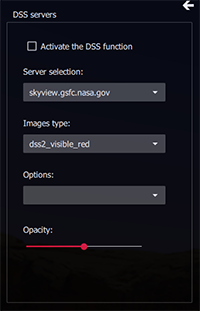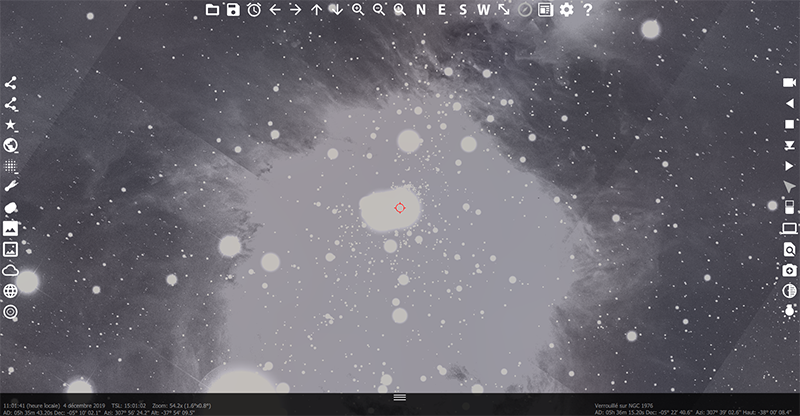DSS function¶

The DSS dialog box allows you to choose the server that is the fastest in relation to your geographical position and to choose the type of survey you want to use.
The photos are superimposed on the images of the sky generated by WinStars. The option Opacity allows you to play on the transparency of the photographic plates.

Note
The Digitized Sky Survey (DSS) is a digitized version of several photographic astronomical surveys of the night sky, produced by the Space Telescope Science Institute between 1983 and 2006. The term Digitized Sky Survey originally referred to the publication in 1994 of a digital version of an all-sky photographic atlas used to produce the first version of the Guide Star Catalog. For the northern sky, the National Geographic Society – Palomar Observatory Sky Survey E-band (red, named after the Eastman Kodak IIIa-E emulsion used), provided almost all of the source data (plate code “XE” in the survey). For the southern sky, the J-band (blue, Eastman Kodak IIIa-J) of the ESO/SERC Southern Sky Atlas (known as the SERC-J, code “S”) and the “quick” V-band (blue or V in the Johnson–Kron–Cousins system, Eastman Kodak IIa-D) SERC-J Equatorial Extension (SERC-QV, code “XV”), from the UK Schmidt Telescope at the Australian Siding Spring Observatory, were used. Three supplemental plates in the V-band from the SERC and Palomar surveys are included (code “XX”), with shorter exposure times for the fields containing the Andromeda Galaxy, the Large and the Small Magellanic Cloud. The publication of a digital version of these photographic collections has subsequently become known as the First Generation DSS or DSS1. After the original 1994 publication, more digitizations were made using recently completed photographic surveys, and released as the Second Generation DSS or DSS2. Second Generation DSS consists of three spectra bands, blue, red, and near infrared. The red part was first to complete, and includes the F-band (red, Eastman Kodak IIIa-F) plates from the Palomar Observatory Sky Survey II, made with the Oschin Schmidt Telescope at Palomar Observatory for the northern sky. Red band sources for the southern sky include the short red (SR) plates of the SERC I/SR Survey and Atlas of the Milky Way and Magellanic Clouds (referred to as AAO-SR in DSS2), the Equatorial Red (SERC-ER), and the F-band Second Epoch Survey (referred to as AAO-SES in DSS2, AAO-R in the original literature), all made with the UK Schmidt Telescope at Anglo-Australian Observatory.